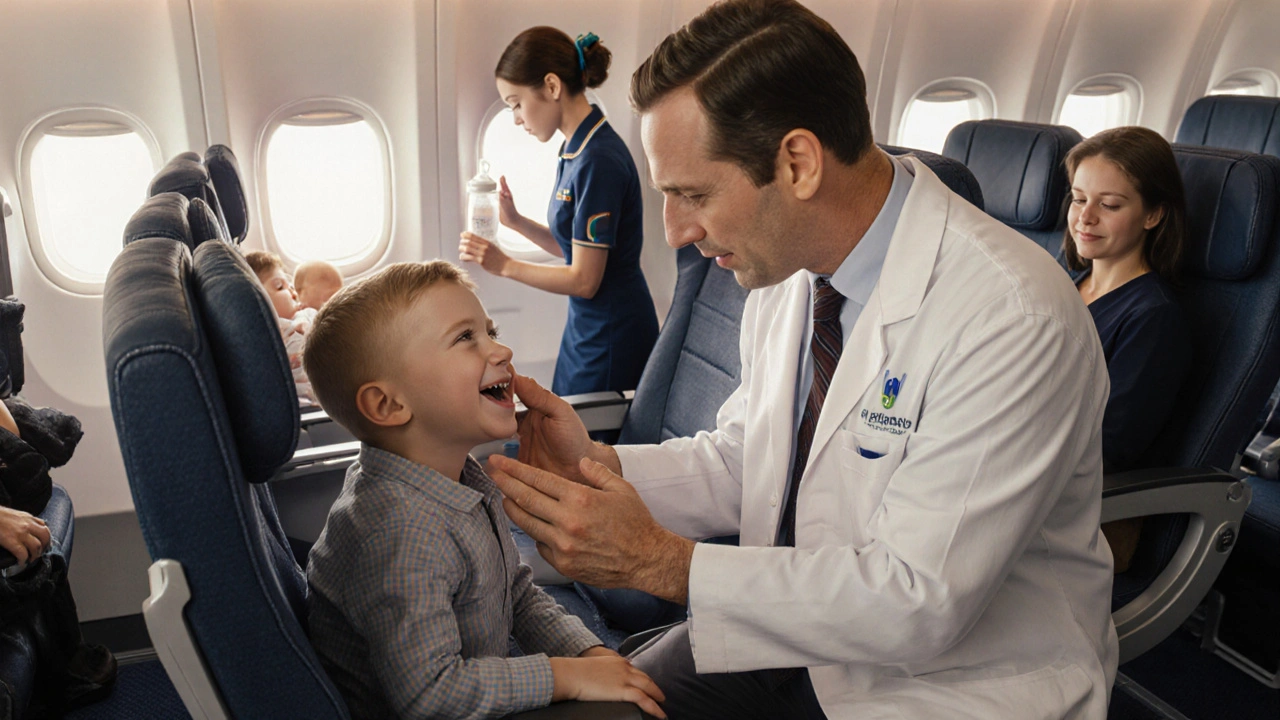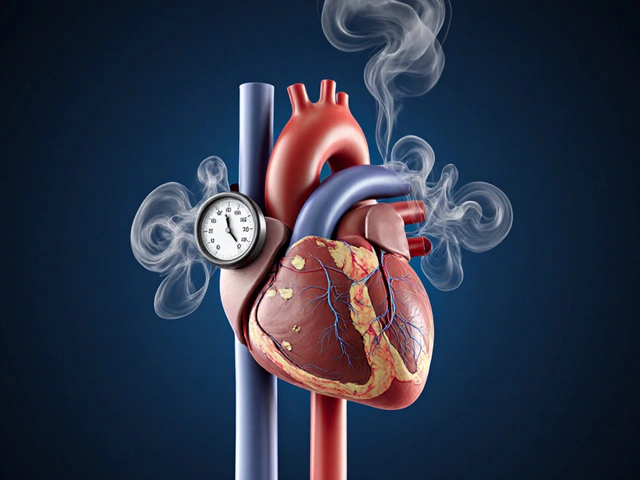Flights can be stressful enough without your ears screaming in pain during takeoff or landing. If you’ve ever felt like your ears are stuffed with cotton, or worse, sharp pain hits when the plane starts descending, you’re not alone. This is called airplane ear, or barotrauma, and it happens when the pressure inside your middle ear doesn’t match the pressure outside. It’s not just uncomfortable-it can cause temporary hearing loss, dizziness, or even a ruptured eardrum in rare cases. But here’s the good news: most of the time, it’s completely preventable.
Why Your Ears Hurt During Flights
Your middle ear is a small air-filled space behind your eardrum. It’s connected to the back of your throat by a tiny tube called the Eustachian tube. Normally, this tube opens when you swallow, yawn, or chew, letting air flow in or out to balance pressure. But during a flight, cabin pressure changes fast-especially during descent. As the plane drops, pressure builds outside your ear, pushing your eardrum inward. If your Eustachian tube can’t open quickly enough, that pressure difference can stretch or even tear the eardrum. Adults experience this about 1 in 10 times, but kids? It’s worse. Nearly 1 in 5 children feel real pain during flights, and that number jumps to 1 in 3 during cold or allergy season. Why? Their Eustachian tubes are smaller-just 17 to 18 millimeters long-compared to 35 to 38 mm in adults. They’re also more likely to be blocked by mucus or swollen tissue from a recent cold.How to Equalize Pressure Before It Hurts
The key isn’t waiting until you feel pain. It’s acting early and often. Start equalizing pressure as soon as the plane begins its descent, around 8,000 feet. Don’t wait until your ears are screaming. By then, it’s harder to fix. Here are the most effective methods, ranked by safety and success rate:- Swallowing and yawning - The safest option. Works for about 65% of people. Chew gum, suck on hard candy, or sip water. This is the first thing you should try.
- Toynbee maneuver - Pinch your nose shut and swallow. It’s gentler than blowing and works for 68% of users. Great for kids and adults who can’t blow hard without discomfort.
- Jaw wiggle - Move your jaw side to side while swallowing. This small trick boosts success by 22% for children, according to ENT specialists in Singapore. It helps open the Eustachian tube by shifting the surrounding muscles.
- Lowry technique - Combine swallowing with gentle blowing. Pinch your nose, swallow, and blow softly at the same time. This works for 89% of people who practice it, but it’s tricky to master on the first try.
- Voluntary tubal opening - Tense the muscles at the back of your throat while pushing your jaw forward. Sounds odd, but it’s 92% effective for trained users. It takes weeks of daily practice to learn, so not ideal for occasional flyers.
Most people don’t need anything beyond swallowing and jaw movement. But if you’re dealing with congestion, you might need a little help.
When to Use Decongestants and Nasal Sprays
If you have a cold, allergies, or sinus congestion, your Eustachian tubes are already swollen. That’s when pressure equalization gets tough. In these cases, decongestants can help-but only if used right.- Nasal sprays (oxymetazoline) - Brands like Afrin reduce swelling in 10 minutes and last 12 hours. Use them 30 to 60 minutes before descent. But don’t use them for more than 3 days in a row-they can cause rebound congestion.
- Oral decongestants (pseudoephedrine) - Sudafed helps open tubes for 8 to 12 hours. Good for adults, but avoid if you have high blood pressure or heart issues. The FDA warns that 12% of adults over 40 experience side effects like rapid heartbeat.
- Nasal steroids (fluticasone) - Sprays like Flonase reduce inflammation over time. Research from the University of Pennsylvania shows using them daily for a week before flying improves equalization by 33%. This is a smart option for frequent flyers with chronic congestion.
For children under 6, avoid oral decongestants entirely. The FDA has documented rare cases of fast heart rate in young kids after taking Sudafed. Instead, give them a bottle or sippy cup during descent. Babies who suck on a bottle equalize pressure 43% better than those who sip from a cup because their swallowing is stronger and more consistent.

Filtered Earplugs: A Quiet Solution
EarPlanes are the most popular filtered earplugs on the market. They’re not noise-canceling-they’re pressure regulators. Inside each plug is a ceramic filter that slows down how fast pressure changes reach your eardrum. Instead of a sudden 40 mmHg shift in seconds, it stretches that change over 28 seconds instead of 15. That gives your Eustachian tube more time to catch up. Studies show they work for 76% of users. But if you have long-term Eustachian tube dysfunction, their effectiveness drops to 42%. They’re not a cure, but they’re a helpful backup. Many travelers combine them with swallowing or jaw wiggles and report success rates above 90%.What Not to Do
Some common habits make airplane ear worse:- Waiting until it hurts - 68% of people who suffer from airplane ear say they waited too long to act. By then, the pressure difference is too big.
- Blowing too hard during Valsalva - Pinching your nose and blowing hard sounds logical, but it’s dangerous. Forcing air into the middle ear can damage your inner ear. The Divers Alert Network found that 41% of barotrauma cases came from overdoing this maneuver.
- Sleeping during descent - If you’re passed out while the plane drops, you’re not swallowing. That’s why 73% of children with ear pain during flights were asleep during descent.
- Using decongestants too close to flight time - Sprays need 30 minutes to work. Taking them right before boarding won’t help.

Advanced Options for Chronic Sufferers
If you get airplane ear every single flight-even when you’re healthy-it’s time to consider medical help.- Otovent device - A small nasal balloon you inflate through your nose. It gently pushes air into the Eustachian tube. Approved by the FDA in 2022, it works in 88% of clinical trials.
- Eustachian tube balloon dilation - A minimally invasive procedure where a tiny balloon is inserted into the tube and inflated to widen it. Success rates are 76% after one year. Costs $3,800 to $5,200 out-of-pocket in the U.S.
- Eustachian tube stents - Still in clinical trials, these tiny tubes keep the passage open. Early results show 92% success. This could be a game-changer for people who can’t fly without pain.
Even airlines are stepping up. Newer planes like the Boeing 787 keep cabin pressure at 6,000 feet instead of the old standard of 8,000 feet. That means less pressure change-25% less stress on your ears. Delta Airlines now uses a gentler 3-degree descent angle instead of 3.5 degrees, slowing pressure changes by 14%.
Pro Tips for Frequent Flyers
- Practice swallowing exercises daily for a week before your flight. One study showed this cuts incidents by 57%. - Keep a small bag of hard candies or gum in your carry-on. Don’t wait for the descent to start chewing. - If you’re traveling with kids, bring their favorite bottle or sippy cup. Feed them during descent. - Avoid alcohol and caffeine before and during the flight. They dehydrate you, making mucus thicker and harder to clear. - If you’ve had ear surgery, talk to your doctor before flying. Some procedures require waiting weeks before flying safely.There’s no magic fix, but with the right tools and timing, you can fly without ear pain. Start simple: chew, swallow, wiggle your jaw. If that doesn’t work, add a nasal spray or EarPlanes. For chronic issues, medical options are improving fast. The goal isn’t to suffer through every flight-it’s to make flying comfortable again.
Can airplane ear cause permanent hearing loss?
In most cases, no. The pain and muffled hearing from airplane ear usually go away within hours or days. But in rare cases-about 0.02% of flights-forcing pressure too hard during the Valsalva maneuver can rupture the eardrum or damage inner ear structures. If hearing doesn’t return within 48 hours or you feel dizziness or ringing, see an ENT specialist.
Is it safe to fly with an ear infection?
It’s not recommended. An active ear infection means your Eustachian tube is swollen and blocked. Flying could make the pain severe or lead to a ruptured eardrum. If you have a fever, pus, or intense pain, delay your flight. If you must fly, use nasal steroids and avoid decongestants. Talk to your doctor first.
Do children outgrow airplane ear?
Yes, most do. As kids grow, their Eustachian tubes lengthen and become more angled, making them easier to open. By age 7, most children experience far less discomfort. Until then, use feeding during descent, jaw wiggles, and avoid decongestants. If a child has repeated issues past age 8, consider an evaluation for chronic Eustachian tube dysfunction.
Can I use EarPlanes with a cold?
Yes, but they’re less effective if your tubes are blocked. EarPlanes work best when your Eustachian tubes can still open-they just need more time. Combine them with a nasal spray or decongestant for better results. If your nose is completely stuffed, EarPlanes alone won’t be enough.
What’s the best time to start equalizing during descent?
Start at around 8,000 feet, which is usually 20 to 30 minutes before landing. Don’t wait for the plane to drop rapidly. Equalize every 300 to 500 feet of descent. That’s about every 2 to 3 minutes. If you’re sleeping, set an alarm. Consistency beats intensity.
If you’ve struggled with airplane ear for years, know that help is getting better. From smarter earplugs to new medical procedures, solutions are evolving. But the most powerful tool is still simple: act early, stay consistent, and don’t ignore the signs. Your ears will thank you.





